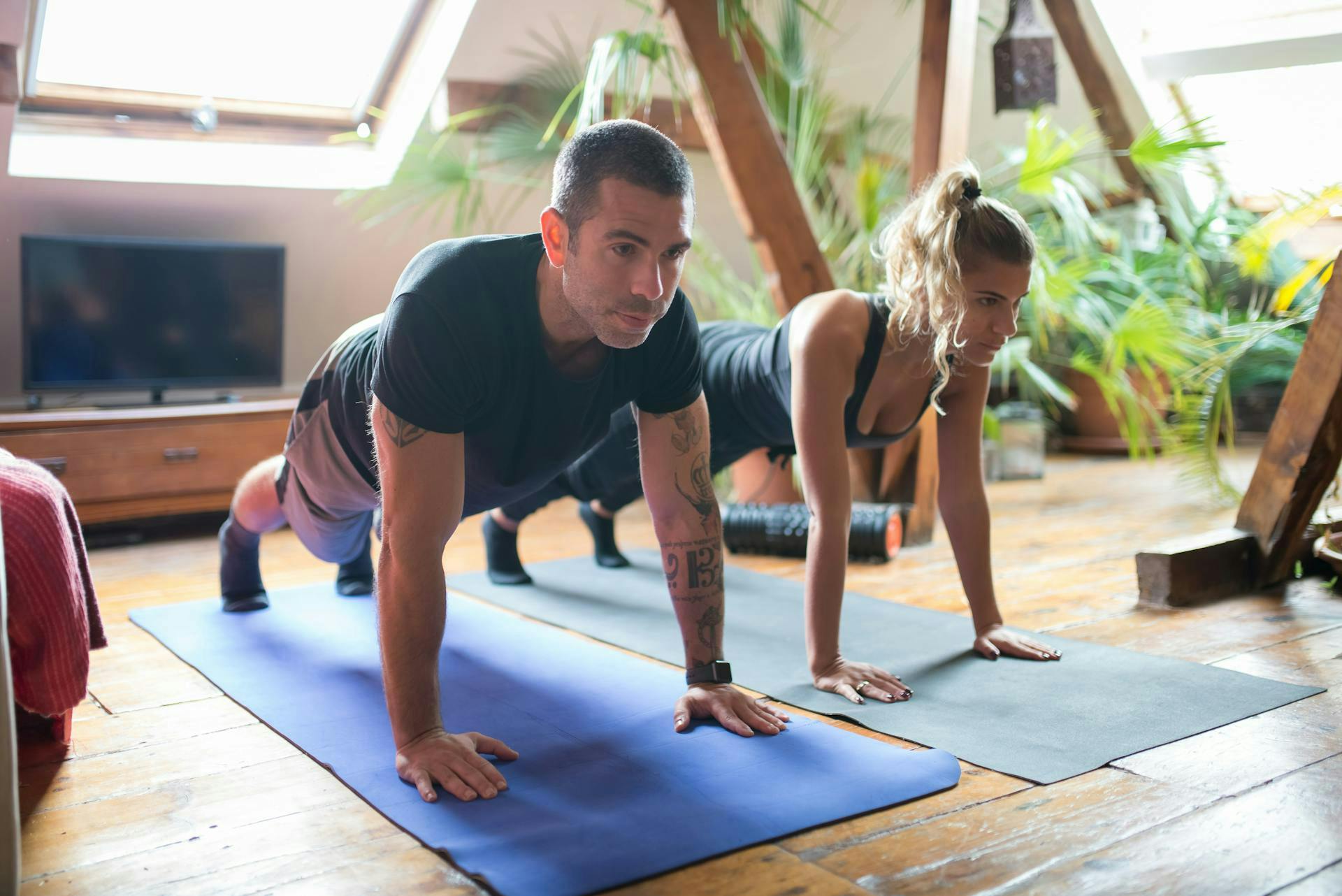Weight Loss Workout Plan for Men & Women: The Best Science-Backed Routine to Burn Fat & Build Muscle
By Lilian E.
Reviewed by Kenya Bass, PA-C
Published May 13, 2025
13 min read

If you're trying to lose weight, you're not alone. One of the most common health goals for both men and women is shedding excess fat and improving overall fitness. But with so much information out there, it's easy to get confused about the best way to start.
Should you hit the treadmill for hours? Focus on lifting weights? Join a class or follow a YouTube video? The truth is, a well-balanced weight loss workout plan doesn’t have to be complicated. It just needs to be consistent, structured, and supported by healthy habits like proper nutrition and sleep.
In this guide, we’ll walk you through how to create the perfect workout regimen for men and women that helps burn fat, build muscle, and improve energy levels. We’ll also touch on important lifestyle habits that can make or break your results. Whether you're new to working out or getting back into a routine, this article is for you.
How Exercise Helps with Weight Loss
Exercise plays a critical role in weight loss. When you move your body, you burn calories. And when you burn more calories than you take in, your body starts to lose weight. But exercise does more than just torch calories—it also boosts your metabolism, improves your mood, and helps you maintain muscle mass while you lose fat.
Strength training, for example, helps build lean muscle, which burns more calories at rest compared to fat. Cardio, on the other hand, helps improve heart health and increases your daily calorie burn. The best fitness plan for men and women includes both.
The combination of cardio and strength training is powerful. Not only does it lead to better fat loss, but it also shapes your body in a way that pure cardio can't. It creates what many call a "toned" look, which is really just lower fat and stronger muscles.
Cardio vs. Strength Training: What Works Best?
Both cardio and strength training are important if your goal is weight loss, but they work in slightly different ways.
Cardio helps you burn calories quickly. Activities like running, biking, swimming, or brisk walking get your heart rate up and can lead to a high calorie burn in a short time. Cardio also improves endurance and heart health.
Strength training, which includes lifting weights or doing bodyweight exercises, helps you build muscle. More muscle means a higher resting metabolism, which means you burn more calories even when you're sitting still.
Some people worry that lifting weights will make them bulky, especially women. That’s a myth. In reality, it takes a lot of time, heavy training, and a specific diet to build large muscles. Most people who lift weights will simply look leaner and more defined.
A smart weight loss workout plan combines both. You might do strength training three days a week and cardio two or three days a week. Or you can do both in the same session with circuit training or HIIT.
What Makes a Good Weight Loss Workout Plan for Men/Women?

A good weight loss plan doesn’t have to be fancy, but it should be:
- Balanced: Includes both strength and cardio.
- Flexible: Fits into your schedule and lifestyle.
- Progressive: Gets more challenging over time.
- Sustainable: Something you can stick to in the long term.
For example, gym routines for men and women might look different depending on goals, but the foundation is often the same: some form of resistance training, cardio, and consistency. The best work out regimen for men might include heavier weightlifting, while a work out regimen for women might focus more on full-body circuits. Still, both benefit from a similar approach.
How Often Should You Work Out to Lose Weight?
If you're new to working out, aim for 3 to 4 days a week to start. As your fitness improves, you can build up to 5 or 6 days. The key is consistency, not perfection.
Try to mix up your routine throughout the week. Here’s an example schedule:
- Monday: Strength (Upper Body)
- Tuesday: Cardio (Moderate intensity)
- Wednesday: Strength (Lower Body)
- Thursday: Rest or light movement (walk, stretch)
- Friday: HIIT or Circuit Training
- Saturday: Core + Conditioning
- Sunday: Rest
This weekly mix provides variety and targets different muscle groups and energy systems.
The Ideal Weekly Weight Loss Workout Plan (Sample Routine)
Let’s look at a beginner-friendly plan that works for both men and women:
Day 1: Full Body Strength
This day focuses on working your major muscle groups all in one session.
Warm-up: Start with dynamic stretching for 5–10 minutes to get your blood flowing and muscles warm. Try:
- Arm circles
- Leg swings
- Walking lunges
- Jumping jacks
Strength exercises (3–6 sets of 6–12 reps each):
- Squats
- Push-ups
- Bent-over rows
- Dumbbell shoulder press
- Deadlifts
- Plank (hold for 30–60 seconds)
Optional Cardio (30 minutes):
- Brisk walking
- Cycling
- Light jogging
- Rowing machine
Cool down: Finish with static stretches, holding each stretch for 15–30 seconds.
Day 2: Cardio
This is your heart-health and fat-burning day.
Warm-up (5–10 minutes):
- Arm swings
- Side steps
- Light jogging in place
Cardio session (30–45 minutes): Pick your favorite aerobic activity. Examples include:
- Running outdoors or on a treadmill
- Swimming
- Biking
- Dance classes
- Playing sports like basketball, soccer, or tennis
Cool down: Do a gentle walk followed by static stretches focusing on your legs and hips.
Day 3: Rest or Gentle Yoga/Stretching
Give your muscles time to recover and repair.
If you're active-resting, do something gentle like:
- A beginner yoga flow (20–30 minutes)
- A light walk
- Foam rolling or a stretching session
This helps reduce soreness and keeps your body limber.

Day 4: Lower Body Strength
Target your glutes, quads, hamstrings, and calves.
Warm-up (5–10 minutes):
- Bodyweight squats
- High knees
- Leg swings
- Glute bridges
Strength exercises (3–6 sets of 6–12 reps each):
- Barbell or dumbbell squats
- Romanian deadlifts
- Lunges (forward or walking)
- Calf raises
- Glute bridges or hip thrusts
- Step-ups (use a bench or sturdy platform)
Optional Cardio (20–30 minutes):
- Stair climbing
- Hiking
- Elliptical trainer
Cool down: Stretch your quads, hamstrings, glutes, and calves—hold each for 15–30 seconds.
Day 5: High-Intensity Interval Training (HIIT)
Quick, intense bursts of movement followed by short rests.
Warm-up (5–10 minutes):
- Jump rope
- High knees
- Arm circles
- Dynamic lunges
Sample HIIT Workout (20–30 minutes): Repeat this circuit 3–4 times:
- 30 seconds jumping jacks
- 30 seconds push-ups
- 30 seconds squat jumps
- 30 seconds mountain climbers
- 30–60 seconds rest
Cool down: Slow walk and deep static stretches to bring your heart rate down.
Day 6: Active Recovery
Light movement to keep your blood flowing without straining your muscles.
Options include:
- A 30–45 minute easy walk
- Leisurely bike ride
- Gentle yoga
- Swimming at a relaxed pace
This day is all about movement without intensity. It helps flush out soreness and keeps you on track without overtraining.
Day 7: Rest
This is your true recovery day. No structured exercise. Focus on sleep, hydration, and stress relief. Let your body recharge so you're ready to hit it hard again next week.
If you’re itching to move, a casual stroll or a few light stretches are totally fine.
This weekly weight loss workout plan can be followed by both men and women. It’s designed to be flexible, realistic, and sustainable for anyone who wants to improve their fitness and lose weight. Whether you're following a work out regimen for men, a work out regimen for women, or just need a fitness plan men and women can both do together, this gives you a strong foundation to build on.
What Types of Workouts Burn the Most Fat?
Certain types of workouts are particularly good at burning fat and helping with weight loss:
- HIIT (High-Intensity Interval Training): Short bursts of intense activity followed by rest. Great for calorie burn and boosting metabolism.
- Strength Training: Builds lean muscle, which burns more calories over time.
- Circuit Training: Combines cardio and strength in a fast-paced format.
- Walking on an incline: Surprisingly effective for burning fat without stressing the joints.
The most important thing is to find something you enjoy. You’ll stick with it longer and see better results.
How to Build a Personalized Workout Plan
Everyone is different. Your ideal weight loss workout plan depends on your goals, fitness level, time, and equipment access.
Start by asking yourself:
- How many days can I realistically work out each week?
- Do I prefer the gym, home workouts, or outdoor activities?
- What types of exercise do I enjoy most?
Then build your plan around those answers. Don’t copy someone else’s fitness plan exactly. Make it yours.
You can also adjust as you go. Maybe start with bodyweight exercises and then add resistance bands or dumbbells. Track your progress. If things feel too easy, increase the challenge. That’s how you grow.
What Makes a Workout Regimen for Men Different from Women?
Truthfully, not much. While men and women have different hormones, both can benefit from similar exercises.
However, men may focus more on upper-body strength, chest and arms. So a gym routine for men might include more bench presses and weighted pull-ups.
Women often ask for glute and leg-focused workouts, so a gym routine for women might include more lunges, hip thrusts, or Pilates-based movements.
But at the core, both groups need strength training, cardio, rest, and good nutrition. There is no "one-size-fits-all," but there is a formula that works when you apply it to your needs.
Daily Movement Beyond Exercise

Formal workouts are great, but they’re only part of the picture. Daily movement matters too.
This includes walking your dog, cleaning the house, gardening, or taking the stairs instead of the elevator. It’s called NEAT (Non-Exercise Activity Thermogenesis), and it can make a big difference in your daily calorie burn.
Try to find ways to stay active throughout the day, especially if you have a desk job. Taking short walks, stretching, or even standing while working can all help.
Supporting Weight Loss with Food, Hydration, and Sleep
You can't out-exercise a poor diet. For your fitness plan to work, you need to support it with healthy food, proper hydration, and quality sleep.
- Food: Eat balanced meals with protein, healthy fats, and fiber-rich carbs. Don’t starve yourself. Fuel your body, especially around workouts.
- Hydration: Aim for at least 8 cups of water a day. More if you’re sweating.
- Sleep: Lack of sleep can increase hunger hormones and reduce recovery. Aim for 7–9 hours per night.
These three areas are just as important as the workout itself. They help your body recover, reduce stress, and keep your metabolism strong.
Tips for Staying Motivated
Weight loss takes time. There will be days you don’t feel like working out. That’s okay. The goal is to build habits, not be perfect.
Find ways to stay motivated:
- Set short-term goals (like walking 10,000 steps a day)
- Track your progress (photos, strength gains, endurance)
- Reward yourself for sticking to your plan
- Mix things up to avoid boredom
Remember, even slow progress is still progress. Keep going.
Common Mistakes to Avoid
- Doing too much cardio and ignoring strength training
- Expecting overnight results
- Not eating enough food (especially protein)
- Skipping rest days
- Comparing your journey to others
It’s okay to make mistakes—just learn from them and keep moving forward.
Conclusion
The best weight loss workout plan for men and women is one you can stick with. It includes strength training, cardio, daily movement, and healthy habits like eating well and getting enough sleep.
You don’t need to be perfect. You just need to be consistent. Start small, keep it simple, and build from there. Whether you're following a gym routine or working out at home, the key is to keep showing up.
Your body will thank you for it.
Frequently Asked Questions (FAQs)
1. What is the best time of day to exercise for weight loss?
Research suggests that morning workouts may offer a slight advantage for weight loss due to hormonal factors and increased fat oxidation. However, the most crucial factor is consistency. Exercising at a time that fits your schedule and can be maintained regularly is key to achieving weight loss goals.
2. How can I break through a weight loss plateau with my workout routine?
Experiencing a plateau is common during weight loss journeys. To overcome it:
- Increase workout intensity or frequency: Incorporate high-intensity interval training (HIIT) or add more workout days.
- Change your exercise routine: Introduce new exercises to challenge different muscle groups.
- Monitor your diet: Ensure you're maintaining a calorie deficit and consuming adequate protein.
Adjusting these factors can help reignite weight loss progress.
3. How can I stay motivated to continue my weight loss workout plan?
Maintaining motivation can be challenging. Consider these strategies:
- Set realistic goals: Break down your weight loss goals into achievable milestones.
- Track your progress: Use journals or apps to monitor workouts and dietary habits.
- Find a workout buddy: Exercising with a friend can increase accountability.
- Reward yourself: Celebrate small victories to stay encouraged.
These approaches can help sustain motivation throughout your fitness journey.
4. How should I track my progress beyond the scale?
While weight is a common metric, consider these additional methods:
- Body measurements: Track changes in waist, hip, and limb circumferences.
- Fitness levels: Monitor improvements in strength, endurance, and flexibility.
- Clothing fit: Notice how your clothes fit over time.
- Energy levels: Assess increases in daily energy and stamina.
5. What should I do if I'm not losing weight despite regular exercise?
If weight loss stalls:
- Evaluate your diet: Ensure you're not consuming more calories than you burn.
- Assess workout effectiveness: Incorporate strength training to build muscle, which can boost metabolism.
- Check for medical issues: Consult a healthcare provider to rule out underlying conditions.
Adjusting these aspects can help resume weight loss.
6. How can I adjust my workout plan if I'm not seeing results?
To enhance your workout plan:
- Implement progressive overload: Gradually increase the weight or resistance in your exercises.
- Diversify workouts: Introduce new activities to challenge your body differently.
- Ensure adequate recovery: Allow time for muscles to repair and grow.
7. Is it better to work out in the morning or evening for weight loss?
Both morning and evening workouts have benefits:
- Morning: May enhance fat burning and establish a routine.
- Evening: Can improve performance and fit better into some schedules.
Choose the time that aligns with your lifestyle and allows for consistency.
8. How can I stay consistent with my workout routine?
Consistency tips:
- Schedule workouts: Treat them as non-negotiable appointments.
- Set achievable goals: Avoid burnout by starting with manageable sessions.
- Mix it up: Incorporate variety to keep workouts interesting.
- Seek support: Join fitness groups or find a workout partner.
These strategies can help maintain a regular exercise habit.
9. What are some common reasons for not losing weight despite exercising?
Potential factors include:
- Inadequate calorie deficit: Consuming more calories than burned.
- Lack of strength training: Missing out on muscle-building exercises.
- Poor sleep: Affecting metabolism and hunger hormones.
- Stress: Leading to hormonal imbalances and overeating.
10. How long does it typically take to see weight loss results from a workout plan?
Initial changes, such as increased energy and improved mood, can occur within a few weeks. Noticeable weight loss and muscle definition may take 4 to 8 weeks, depending on factors like workout intensity, diet, and individual metabolism.
11. How soon will I see results?
If you’re consistent, most people start noticing changes in 3 to 6 weeks. That includes better energy, improved strength, and slight changes in body composition.
12. Do I have to go to the gym?
No. You can lose weight at home with bodyweight workouts, walking, and simple equipment like resistance bands.
13. Can I work out every day?
You can move every day, but don’t push hard every day. Include light days and rest days to recover.
Share this article

Magnesium for Weight Loss: Benefits, Risks, and What Science Really Says
Dr. Jossy Onwude, MD
Sep 29, 20259 min read

Mounjaro® Sulfur Burps Explained: Causes, Symptoms, and Science-Backed Remedies
Dr. Priyali Singh, MD
Sep 25, 202511 min read

Low Sodium Diet: Simple Guidelines, Food Lists, and Tips for Better Health
Lilian E.
Sep 30, 202512 min read

Best-in-class care is a click away
Find everything and everyone you need to reach your metabolic health goals, in one place. It all makes sense with Meto.
Join Meto